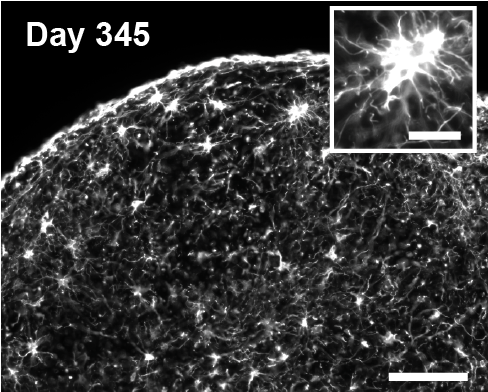Stalking brain cancer’s shapeshifters – and their healthy counterparts

Intermediate stage of astrocyte development identified
Glioblastomas, the most aggressive form of brain cancer in adults, are known as shape-shifters. Glioblastoma cells have the ability to transition from resembling one healthy type of brain cell to another, accounting for their resistance to targeted therapies.
Astrocytes, which are glioblastomas’ healthy counterparts in the developing brain, appear to go through a previously unidentified maturation state mirrored in glioblastoma tumors. The findings are published in Nature Cell Biology.
Emory scientists identified the new stage of astrocyte development by studying human brain organoids, which are brain-like structures derived from induced pluripotent stem cells and grown in culture. Through a collaboration with Winship Cancer Institute neurosurgeons, the team compared organoid-derived astrocyte cells with glioblastoma cells collected directly from patient tumors.
Knowing where glioblastomas come from could help researchers develop anti-cancer therapies that limit their malevolent potential, says Steven Sloan, MD, PhD, associate professor of human genetics at Emory University School of Medicine and senior author of the paper.
“Understanding the pathways active during astrocyte development, which may be different from those in play in astrocytes’ mature state, may provide new targets for small molecule therapy or immune-based interventions,” says Jeffrey Olson, MD, professor of neurosurgery at Emory and Winship Cancer Institute, who worked with Sloan’s lab to provide patient tissue samples.
Although astrocytes are one of the most abundant cell types in the brain, relatively little is known about the features of their development, particularly in humans, because they mature mostly during late fetal life and infancy, and access to tissue samples is limited. Organoid cultures can be maintained for many months, or even years, to help understand how human brain development occurs throughout late fetal and early prenatal stages.
“Organoids represent an ideal tool for filling in the gaps in how astrocytes develop, which has been shrouded in mystery,” Sloan says. “Going into this project, we didn’t really know that this intermediate stage of astrocytes’ development existed.”
In the brain, astrocytes have been conventionally thought of as passive supportive cells, in contrast to neurons. More recent studies have highlighted astrocytes’ role as partners for neurons in forming and maintaining synapses, and a reservoir of regenerative potential after brain injury.
In the Nature Cell Biology paper, the authors analyzed the gene activity patterns in cells from organoids that mimic the brain’s cortex -- for extended time periods as long as 550 days. Most investigators in the field rarely go past 90 days, Sloan says.
This extended time frame allowed researchers to observe how a distinctive set of genes are turned on during an intermediate stage of astrocyte development, between dividing progenitor and differentiated cells. This intermediate stage may still have the potential to become more than one type of cell. Other laboratories have identified similar cells that have the capacity to transition between variety of cell types, including neurons, astrocytes and oligodendrocytes.
“If this middle stage represents a multipotent cell type, it could explain the plastic nature of glioblastoma tumors and why they’re more able to evade treatment,” says Caitlin Sojka, PhD, a former Emory graduate student and the lead author of the paper.
The researchers also observed how some tumors carrying certain mutations in the IDH1 gene produce a metabolite that warps their gene activity patterns, but that metabolite also seems to suppress glioblastomas’ wild, immature tendencies. This may provide clues on therapeutic development, the authors say.
This study was supported by the National Institute of Mental Health (R01MH125956) and the National Institute of Neurological Disorders and Stroke (R01NS123562), the Sontag Foundation and the Brain & Behavior Research Foundation.

